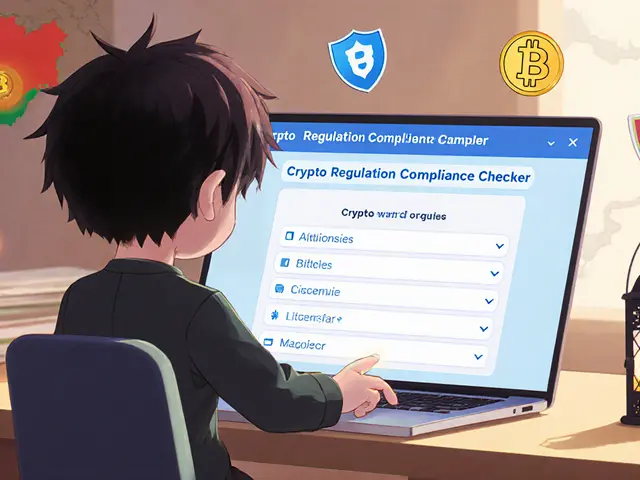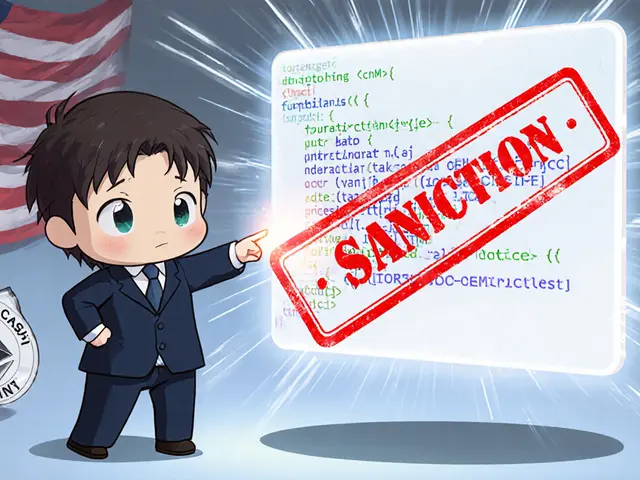DeFi Collateral Calculator
How It Works
Enter your collateral assets to see your maximum borrowable amount. Multi-collateral systems allow you to use multiple assets with different risk discounts (haircuts).
Total Borrowable Amount
Based on 66% loan-to-value ratio
When you borrow money in traditional banking, you put up your house or car as security. In DeFi, you do the same-but instead of a house, you lock up Bitcoin or Ethereum. The big question is: should you lock up just one type of crypto, or can you use several? That’s where multi-collateral and single-collateral systems come in. These aren’t just technical details-they shape how much control you have, how risky your loans are, and whether your money works harder for you.
What Is a Single-Collateral System?
A single-collateral system lets you borrow against only one asset. The most famous example is MakerDAO’s original SAI stablecoin, which ran from late 2017 until late 2019. Back then, the only thing you could use to borrow DAI was Ethereum-specifically, Pooled Ether (PETH), a tokenized version of ETH locked in a smart contract. Here’s how it worked: if you wanted $100 in DAI, you had to lock up at least $150 worth of ETH. That 150% over-collateralization acted as a buffer. If ETH’s price dropped suddenly, the system would automatically sell off your ETH to cover the loan. Simple. Predictable. Easy to understand. But that simplicity came at a cost. If you held Bitcoin, Solana, or even USDC, you couldn’t use them. You had to sell them first, buy ETH, and then lock it up. That meant extra fees, more steps, and missed opportunities. And if ETH crashed hard, the whole system had to liquidate ETH to stay solvent-which could make the crash worse by flooding the market with more ETH.How Multi-Collateral Systems Changed Everything
In November 2019, MakerDAO switched to Multi-Collateral DAI. That was a turning point for DeFi. Suddenly, you could use Bitcoin, Ethereum, Chainlink, Uniswap tokens, and even stablecoins like USDC as collateral. The system didn’t care what you deposited-it added up the total value, applied a haircut (a discount for risk), and let you borrow against it. For example, you could deposit $5,000 in BTC, $3,000 in ETH, and $2,000 in USDC. The system might apply a 30% haircut to BTC, 20% to ETH, and 5% to USDC. That gives you a total collateral value of around $8,900. You could then borrow up to $5,933 in DAI (66% of $8,900). No need to convert anything. No waiting. Your portfolio just got a lot more useful. This flexibility didn’t just make life easier-it unlocked new financial tools. You could now borrow DAI and use it to buy Apple stock tokens on-chain, or lend out your collateral to earn yield elsewhere. Multi-collateral systems turned crypto wallets into dynamic financial hubs, not just storage boxes.Why Multi-Collateral Is More Efficient
Think of your crypto portfolio like a toolbox. With a single-collateral system, you can only use one wrench. With multi-collateral, you can use the hammer, the screwdriver, the pliers-all at once. The capital efficiency gain is real. A trader holding a mix of altcoins no longer has to dump half their portfolio just to access leverage. They can keep their positions intact and still borrow against them. That’s huge for long-term holders who don’t want to sell but still need liquidity. Also, risk is spread out. If ETH crashes, your BTC and USDC can help cover the gap. In a single-collateral world, if ETH drops 40%, your position is likely liquidated. In a multi-collateral system, you might still be safe because your other assets held their value-or even rose.
The Hidden Costs of Complexity
Multi-collateral isn’t magic. It’s more complex-and complexity has a price. First, there are haircuts. Not all assets are treated equally. Bitcoin might get a 30% haircut because it’s volatile. Stablecoins like USDC get 5% because they’re stable. Some obscure tokens? Maybe 50% or more. These aren’t random-they’re based on historical volatility, liquidity, and smart contract risk. Then there are conversion fees. If you deposit a token that isn’t directly supported, the system might need to swap it first. That costs gas and exchange fees. Worst of all: correlation risk. What if Bitcoin, Ethereum, and Solana all crash at the same time? That’s not impossible. In 2022, we saw entire crypto markets drop 70% in weeks. Multi-collateral systems rely on diversification-but during black swan events, diversification can vanish. MakerDAO handles this with auctions. When a vault gets undercollateralized, the system doesn’t just sell your ETH. It first sells MKR tokens (Maker’s governance token) to raise DAI. Then it auctions off your collateral. The proceeds buy back MKR, undoing the dilution. It’s a clever feedback loop-but it’s also harder to explain to newcomers.Who Benefits Most From Each System?
Single-collateral systems are great for:- Beginners learning DeFi for the first time
- Regulated environments where simplicity is required
- Projects testing new ideas without complex risk models
- Active traders managing diversified portfolios
- Long-term holders who need liquidity without selling
- Developers building derivative products (like tokenized stocks or bonds on-chain)

The Future: Automation, Cross-Chain, and Real-World Assets
Multi-collateral systems aren’t standing still. The next wave includes:- Automated rebalancing: Your collateral mix gets adjusted automatically to maintain optimal risk levels.
- Cross-chain collateral: You can lock up assets on Solana, Polygon, or Arbitrum and use them to borrow DAI on Ethereum.
- Real-world asset integration: Some protocols now allow tokenized bonds, real estate, or even gold as collateral. MakerDAO has tested price feeds for Apple stock-meaning you could borrow DAI against a stock you don’t even own.
Which One Should You Use?
Ask yourself:- Do you hold mostly one crypto? Then single-collateral might be fine.
- Do you have a mix of BTC, ETH, SOL, and stablecoins? Then multi-collateral saves you time, fees, and missed gains.
- Are you worried about liquidations? Multi-collateral gives you more breathing room-but only if you understand haircuts.
- Do you want to build financial products on-chain? Then multi-collateral is non-negotiable.
Final Thoughts
Single-collateral systems are like a bicycle: simple, reliable, easy to fix. Multi-collateral is like a car: more complex, needs maintenance, but gets you farther, faster, and with more cargo. MakerDAO’s shift from SAI to Multi-Collateral DAI wasn’t just a technical upgrade-it was a philosophical one. DeFi wasn’t meant to be a copy of banking. It was meant to be better. And that means using all the tools you have, not just one. If you’re still using a single-collateral system because it’s familiar, ask yourself: are you holding back your crypto-or letting it work for you?What’s the difference between single-collateral and multi-collateral systems?
Single-collateral systems let you borrow against only one type of asset, like Ethereum. Multi-collateral systems let you use multiple assets-Bitcoin, stablecoins, tokens, and more-all at once. The value of all your deposits is combined, minus risk discounts, to determine how much you can borrow.
Why did MakerDAO switch from single to multi-collateral?
MakerDAO switched in November 2019 to give users more flexibility. Before, you had to buy Ethereum just to borrow DAI. After the switch, you could use Bitcoin, USDC, or other tokens. This made DAI more accessible, increased liquidity, and reduced pressure on Ethereum during market downturns.
Are multi-collateral systems riskier than single-collateral ones?
They’re more complex, not necessarily riskier. Single-collateral systems are vulnerable to one asset crashing. Multi-collateral spreads the risk-but if all your assets drop at once (like in a crypto-wide sell-off), you’re still exposed. That’s why haircuts, price oracles, and auction mechanisms are critical.
What’s a haircut in DeFi collateral?
A haircut is a discount applied to your collateral to account for volatility. For example, if you deposit $1,000 in Bitcoin and the haircut is 30%, only $700 counts toward your borrowing power. Stablecoins like USDC might have a 5% haircut. Higher risk = bigger haircut.
Can I use real-world assets as collateral in DeFi?
Yes-some protocols now allow tokenized real estate, bonds, or even stock indices as collateral. MakerDAO has tested price feeds for Apple stock, letting users borrow DAI against virtual Apple shares. This is still experimental but shows where the industry is headed.
Is single-collateral still used today?
Rarely for major protocols. MakerDAO’s SAI was discontinued in 2019. Some small or experimental projects still use single-collateral for simplicity, especially in regulated environments or educational settings. But most DeFi platforms now support multi-collateral because it’s more efficient and user-friendly.







David Hardy
November 24, 2025 AT 15:08Anne Jackson
November 25, 2025 AT 13:52Caren Potgieter
November 26, 2025 AT 08:50Linda English
November 27, 2025 AT 01:54